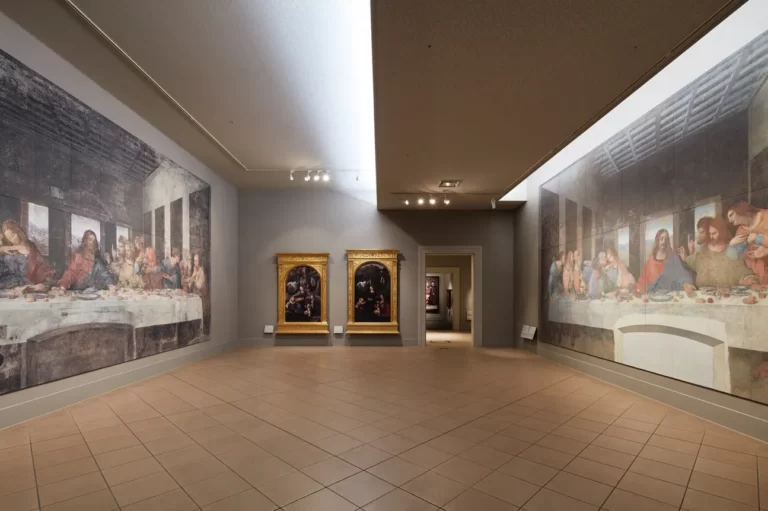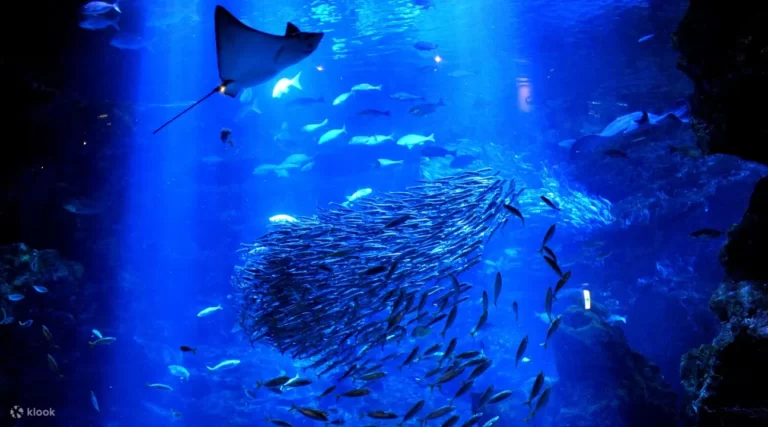Circle September 10th to 24th on your 2023 calendars, and get ready to dive headfirst into the world of Sumo at the September Grand Sumo Tournament, otherwise known as Aki Basho. This action-packed sporting extravaganza is a marquee event in Japan’s national sport, providing a perfect platform to immerse yourself in the enthralling universe of Sumo.
Tickets Officially go on sale on August 5th and they get snapped up almost instantly. More below on how to make sure to secure your ticket.
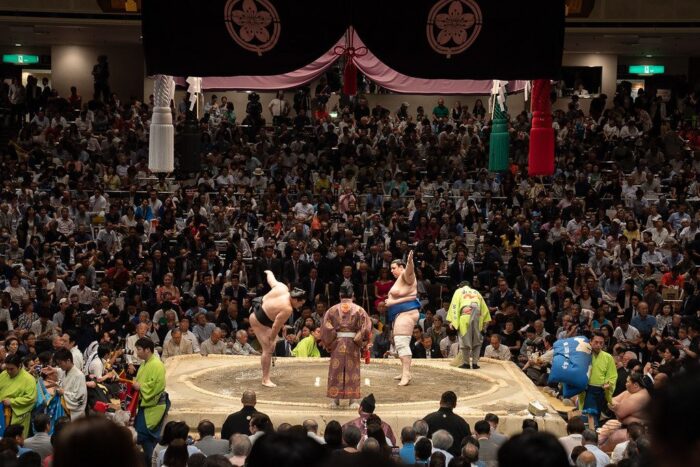
Set within the pulsating heart of Tokyo’s Sumo scene, the Ryōgoku Kokugikan, this event promises to be a spectacle of strength, agility, and strategic acumen.
Rikishi, or wrestlers, from all corners of Japan will vie for supremacy in bouts that are as riveting as they are intense. Consider this guide your roadmap to the thrilling journey that is the 2023 tournament.
Sumo
In essence, Sumo is an elegant dance of balance and power where two rikishi lock horns in a dohyō (ring). Their mission? To force their opponent out of the ring or make them touch the ground with anything other than the soles of their feet. Although the objective sounds simple, each match is woven with intricate Shinto rituals, turning it into a captivating tableau of sport meeting tradition.
Every Grand Sumo tournament, or basho, is a 15-day fiesta segmented into different divisions. The pièce de résistance of each day? The high-stakes bouts in the Makuuchi, the top division.
The September Grand Sumo Tournament 2023
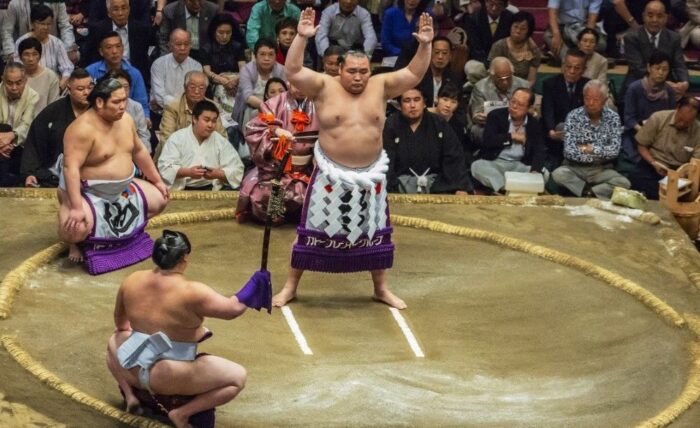
As one of the six annual Honbasho (official tournaments), the Aki Basho holds a coveted spot in the Sumo calendar. The 2023 September Grand Tournament running from the 10th to the 24th of September is set to sizzle with anticipation, as rikishi from all ranks set their eyes on the prestigious Emperor’s Cup.
The tournament is a thrilling stage where the old guard defends their stronghold, new challengers ascend the ranks, and surprise victories add a dash of unpredictability. All this makes the Aki Basho an event you simply cannot afford to miss.
Every single day of the tournament unfolds a riveting saga of intense matches, leading to the grand finale on the 24th of September, where the championship often hangs in the balance till the very end.
Whether you are lucky enough to witness the spectacle from the stadium seats or are tuning in from across the globe, prepare to experience the heart and soul of Sumo: a clash of strength, strategy, and skill, with a sprinkle of luck thrown in for good measure.
How To Buy Tickets To The September Grand Tournament?
When planning your visit to Aki Basho 2023, securing tickets should be at the top of your to-do list. With both local and international Sumo fans eager to catch the action, tickets can sell out quickly.
Tickets for the tournament go on sale about a month in advance which is August the 5th for the 2023 Grand Tournament, and you can purchase them through the official Japan Sumo Association website or via licensed vendors. They offer various types of seats ranging from ringside seats (Tamari-seki), box seats (Masu-seki), and balcony seats (Isu-seki).
Tamari-seki provides the closest view to the dohyō but is also the most expensive. Masu-seki is a popular choice, where four people sit in a boxed area on cushions. For a more economical option, consider Isu-seki or balcony seats, where you’ll be seated on a chair.
Ensure to book your tickets early, especially if you plan on attending the final days of the tournament, which often sell out weeks in advance.
Where To Buy Sumo Tickets
Navigating the ins and outs of purchasing Sumo tickets can feel a bit like a match itself. Don’t fret, we’ve got you covered.
Ticket Oosumo – The Official Gateway
Your first port of call should be Ticket Oosumo, the official Sumo ticket hub. They’ve got an English section to cater to non-Japanese speakers, so getting your tickets online should be a breeze. Just remember, like a rikishi’s thunderous charge at the initial clash, these tickets fly off the virtual shelves pretty quickly.
If you miss the golden window of ticket release, you might find yourself watching the tournament on TV instead of the live action. The website itself can feel like a riddle wrapped in an enigma, just like understanding a rikishi’s pre-match ritual, but with a bit of patience, you’ll figure it out.
And remember that the all-important date when the tickets are released is Saturday, August 5th 2023.
One word of caution though, just as in Disneyland, foreign cards can sometimes face the cold shoulder here.
Sumo Ticket Tour Packages – Hassle-free Sumo Adventure
If you’re more into enjoying the ride than hustling in the trenches, Sumo Ticket Tour Packages are your best bet. These all-inclusive deals hand you not just the coveted tickets (usually box seats, no less), but also a guide well-versed in the art of Sumo. Oh, and did we mention the sumptuous Chanko lunch?
Ideal for first-time Sumo spectators, these packages let you soak up the nuances of Sumo culture, the rulebook, and the expected etiquette, all served by your guide in easy-to-understand bites.
Ticket Pia Store
If serendipity has you in Japan on the day tickets are released, and you’re not one to shy away from a bit of queue, then make a beeline for a Ticket Pia store (there’s one in the Shibuya 109 Building.
Just check the sale date on the Sumo Federation website, brace yourself for a bit of waiting, and you could be holding your ticket to one of the most exciting sporting events Japan has to offer. 7Eleven also has a Pia store on its touch screens which might also be worth trying.
Getting to Ryōgoku Kokugikan

Ryōgoku Kokugikan, located in the Sumida Ward of Tokyo, is easily accessible by public transportation. It’s just a short walk from Ryōgoku Station on the JR Sobu Line and the Toei Ōedo Line.
Upon arrival, take a moment to appreciate the grandeur of Ryōgoku Kokugikan, a symbol of Sumo’s prestige in Japan. Its distinctive green roof and large structure make it a standout feature in the Ryōgoku neighborhood, an area renowned for its deep connections with Sumo culture.
Inside the Venue
Entering Ryōgoku Kokugikan is like stepping into a different world, one pulsing with anticipation, excitement, and deep respect for tradition. The arena can accommodate over 11,000 spectators, each of whom contributes to the unique atmosphere of a live Sumo tournament.
Seating Options
Understanding the seating options at Ryōgoku Kokugikan will help you choose the best viewing experience for your budget and preferences.
Ringside Seats (Tamari-seki)
For the most immersive Sumo experience, consider the Tamari-seki or ringside seats. These are the closest to the dohyō, offering an unparalleled view of the bouts. Be prepared, though – rikishi have been known to tumble into these seats during particularly fierce matches.
Box Seats (Masu-seki)
The Masu-seki, or box seats, are a traditional and popular choice. Each box is delineated by a small fence and accommodates four people sitting on cushions on the floor. These seats offer a good view of the action and a taste of traditional Japanese seating.
Balcony Seats (Isu-seki)
For those seeking a more conventional seating option, the Isu-seki or balcony seats offer stadium-style chair seating. While they are farther from the dohyō, these seats provide a great overview of the entire venue and are a more economical choice.
Remember, all seating options come with their unique advantages, and there’s no wrong choice – just different ways to experience the captivating world of Sumo.
The Match Day Experience

A full day at a Sumo tournament can last from 8:30 AM until 6:00 PM, with lower-division matches taking place in the morning, and the top-division bouts happening in the afternoon. The excitement intensifies as the day progresses, peaking with the arrival of the Makuuchi division rikishi, marked by a traditional ring-entering ceremony known as dohyō-iri.
As a spectator, you can also take part in certain traditions, such as stomping your feet in anticipation of a significant bout or joining the chorus of cheers when a wrestler wins.
Food and Drink at the Tournament
A day at the Sumo tournament isn’t complete without sampling some of the food and drink on offer at the venue. Sumo isn’t just about the action in the dohyō; it’s also a social and cultural event, where friends, families, and strangers share in the communal joy of good food and exciting matches.
Inside the Ryōgoku Kokugikan, you’ll find an array of food options. Try the chankonabe, a hearty stew that Sumo wrestlers eat to maintain their massive size, or yakitori, skewered grilled chicken. Also available are bento boxes, perfect for a quick and convenient meal.
As for drinks, sake is the common choice for many spectators, though sake and beer are also available.
What Happened Last Year? 2022’s Dramatic September Tournament
As the echoes of last year’s thrilling September Grand Sumo Tournament still resound in the Ryōgoku Kokugikan, let’s take a step back and relive the drama and exhilaration of 2022’s showdown.
At the heart of the action, defying the odds and the sands of time, was Tamawashi. With his second career top-division yūshō securely in his hands, he not only defeated his final adversary, former ōzeki Takayasu, but also the record books. At 37 years and 10 months, Tamawashi stole the spotlight as the oldest yūshō winner in the era of the six-tournament system, a record unbroken since 1958. He also reignited a decades-old narrative by being a maegashira ranked wrestler clinching the title, a feat last seen in 1991.
Even in defeat, Takayasu stood tall, finishing the tournament with an honorable 11-4 record. He, along with Tamawashi, found their commitment and resilience rewarded with sanshō prizes. Tamawashi’s performance was recognized as Outstanding, earning him his second Shukun-shō, while Takayasu’s indomitable spirit won him his sixth Kantō-shō. This award saw him joining ranks with former ōzeki Tochinoshin, in terms of the highest tally of sanshō prizes amongst the current warriors of the dohyō.
Tobizaru, the top maegashira, soared with a 10-5 record, adding another Shukun-shō to his collection. Meanwhile, sekiwake Wakatakakage’s technical prowess was not left unnoticed, as he added a fourth Ginō-shō to his trophy shelf.
Ryūden, on his first tournament as a maegashira since his 2021 COVID-related hiatus, reentered the ring with a mighty roar, ending the tournament with 11 wins. Of the three ōzeki, only Takakeishō managed to emerge victorious, securing a 10-5 winning record.
In contrast, Shōdai and Mitakeumi found themselves balancing on the edge of their ranks. With 4-11 scores, Shōdai stepped into kadoban status for November’s tournament, and Mitakeumi faced demotion, needing ten wins to claw his way back up to ōzeki rank.
Reflecting on these epic battles and from 2022, we are left brimming with anticipation for the 2023 September Grand Sumo Tournament. If history is anything to go by, we can expect nothing less than a breathtaking display of power, agility, and Sumo spirit.
Exploring Sumo Culture
A visit to the September Grand Sumo Tournament isn’t just about watching the matches; it’s an opportunity to delve deeper into Sumo culture. In the Ryōgoku area, you can explore Sumo stables, where rikishi train, or visit the Sumo Museum located within Ryōgoku Kokugikan itself, which provides insight into the sport’s long history.
Sumo Stables
Sumo stables, or heya, are an essential part of the Sumo world. They are training grounds where rikishi live and prepare for tournaments under the guidance of a stable master. Several stables are scattered around the Ryōgoku area, and while they are not typically open to the public, some allow visitors to watch morning practice sessions. It’s an intimate way to witness the discipline and effort rikishi put into their craft.
Remember to observe proper etiquette if you get a chance to visit a stable: be quiet, avoid flash photography, and refrain from walking around during the training session.
Sumo Museum
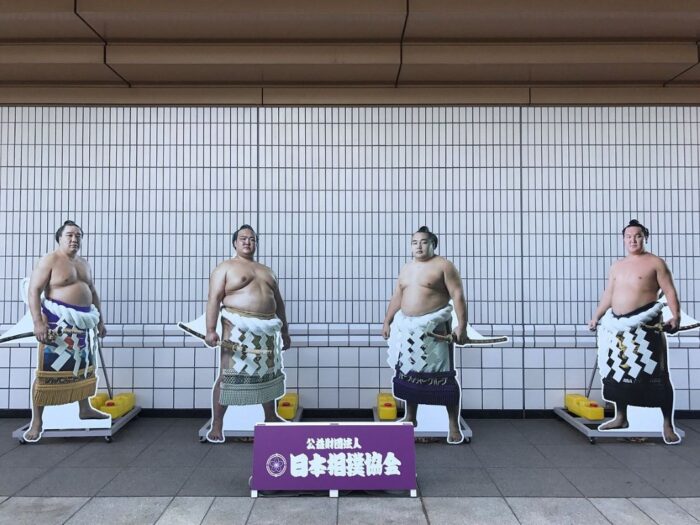
The Sumo Museum, located inside Ryōgoku Kokugikan, is a small but interesting treasure trove of Sumo history and culture.
The museum houses a collection of artifacts related to the sport, including ornate aprons worn by rikishi during ring-entering ceremonies, historical prints of famous Sumo matches, and a variety of memorabilia. Entrance to the museum is free, and it’s a must-visit for any Sumo fan.
The Sum Up
The September Grand Sumo Tournament in Tokyo 2023 is more than just a sporting event; it’s a celebration of a centuries-old tradition, an exhibition of athletic prowess, and a cultural experience that is uniquely Japanese. Whether you’re a long-time Sumo enthusiast or a newcomer to the sport, Aki Basho offers a captivating glimpse into a world where power meets grace, strategy is key, and every match tells a story.
Don’t miss this opportunity to immerse yourself in the world of Sumo. So make sure to secure your tickets and make your way to Ryōgoku Kokugikan, and prepare for an unforgettable experience at the September Grand Sumo Tournament in Tokyo 2023.



